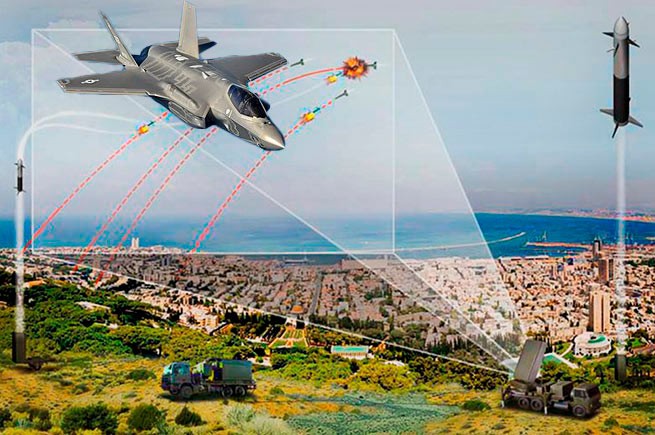The successful countering of an Iranian attack by Israeli air defenses during Operation Iron Shield has encouraged the Greek military, as the emergence of an intense attack using drones, cruise missiles and ballistic missiles is one of the key scenarios in the operational planning of the armed forces.
Already in 2021, immediately after the Greek-Turkish crisis with the Oruz Rais vessel, the Joint Chiefs of Staff began preparing a detailed study, which even received the approval of the Council of Chiefs of Staff (ΣΑΓΕ) and contains three plans to strengthen the Greek air defense.
The expensive scenario involves the purchase of a large number of weapons systems, sensors and ammunition worth more than 6 billion. The next, almost half the price, involves the modest purchase of air defense systems to strengthen the country's anti-aircraft capabilities against modern threats. A much cheaper one, not exceeding 2 billion, involves mainly upgrading existing systems.
Anti-aircraft dome
Speaking on SKAI television, Nikos Dendias said that Greece is starting to create an anti-aircraft unmanned dome modeled on the Israeli Iron Dome. As K previously reported, Evros and the islands of the eastern Aegean are acquiring a drone jamming system, which at the next stage will be extended to the central Aegean and Crete, and in the future to the northern border of the country.
The main feature of this system is the emission of interference aimed at causing the pilot to lose control of the UAV (Soft Kill). However, the goal of the staff is to interface the system through the NACC (National Air Operations Center) with the anti-aircraft weapons available to the armed forces in order to shoot it down (Hard Kill).
The system, which has a number of similarities with Israel's Iron Dome in terms of detection and early warning of a potential threat, will have two versions. “Airborne” will be installed on vehicles or platforms such as aircraft and ships to cover as wide an area as possible and deploy it in areas where critical infrastructure is located. “Stationary” will work with small and medium-sized drones to detect and identify threats.
The anti-drone system, combined with existing anti-aircraft weapons, can largely meet the country's operational needs, competent sources said, but it is clear that sooner or later the air defense will have to be strengthened with new systems.
Missile defense
The study, prepared in 2021, envisages a gradual withdrawal of Russian weapons covering a significant portion of the air defense, as due to the inability to maintain them in the current geopolitical environment, their operational life should be completed within the next five years. According to relevant sources, Greece turned to Armenia for know-how and spare parts, but the efforts were unsuccessful.
Greek personnel have already studied the capabilities of the Israeli Arrow and Barak systems to enhance defense against missiles. attacks. The amount of supplies is estimated at almost 2 billion euros and will largely cover the country's operational needs, although at the moment a decision on this has not yet been made.
https://www.youtube.com/watch?v=gTKb7Ffcv2I
F-35 as a missile hunter
An important conclusion drawn from Operation Iron Shield, which aroused the interest of the Greek command, was the use of a combination of methods, namely anti-aircraft weapons and fighters, to counter Iranian attacks. More specifically, according to media reports, it was mainly Israeli and allied F-16, F-15 and Typhoon aircraft that shot down the unmanned Shaheds, and some UAVs were intercepted by the Iron Dome. However, the “hunt” for cruise missiles was assigned to the F-35.
Israeli officials said F-35s were flying over Syrian airspace on Saturday evening and, thanks to their long-range AESA radars (as well as US long-range surveillance aircraft), were able to detect Iranian missiles from a very long distance. This gave the pilots time to see the missile's flight path and turn in its direction in time, wait for it to catch up with them, and then shoot it down with Python air-to-air missiles. The tactics paid off 100%: the Israeli Air Force announced the downing of all cruise missiles launched by Iran. How much was actually missed is unknown, as it is an Israeli military secret.
Flaws
Despite all the widely publicized advantages of the Iron Dome system, which worked in conjunction with the F-35, this system has its own nuances and disadvantages.
1. The Israeli Air Force F-35 worked closely with the US Navy and Air Force, and used all the data that was given to them by US Navy radars, as well as data from radars located on the territory of US bases in Jordan. Naturally, in the event of an attack from Turkey, the United States will not give Greece a similar opportunity.
2. The distance between the launch point of the “martyrs” and Israel was on average more than 1000 km. Between Greece and Turkey, with its common border and distances, we can talk about meters.
3. The United States annually provides Israel, as its strategic ally, with $15 billion in military assistance alone. After the Hamas attack, several tens of billions of euros more worth of weapons were transferred to Israel. Greece has one Patriot battery, which it leased to Saudi Arabia several years ago. The reason is banal – no money. Not only is there no money for another Patriot battery, but it is also unknown where to get it for the Iron Dome, since the situation in the country’s economy leaves much to be desired. And 13 billion euros have already been spent on the purchase of weapons systems, which were actually borrowed.
4. The new Iron Dome system costs 6 billion, while the stock of missiles included in the (expensive) delivery will be enough for several hundred targets at most. Considering Turkey’s capacity in UAV production, this will not be enough to repel even 1 attack. Not to mention a missile attack, which, due to the proximity of territories and the level of technology, will be noticeably stronger than that of Iran.
5. The territory of Greece is disproportionately larger than the territory of Israel, which raises the question that systems like the Iron Dome are needed 10 times more to protect the territory. And even if we protect critical military and civilian infrastructure, and at a minimum both capitals, there is no way to get by with just one system.
6. Now the cost of an F-35 flight hour is about 42-45 thousand US dollars. It is still unknown what the cost of a flight hour will be for those models that Greece ordered at 240 million apiece. Obviously noticeably higher, since the cost of an aircraft flight hour is formed not only from the cost of fuel and consumables (pay for the pilot, technicians, hangar, etc.), but also from the depreciation of the aircraft, which costs almost 10 times more than the F-16. Will the Greek budget be able to handle such expenses? If it is already stagnating and showing extremely little growth only because of inflation.







More Stories
Borrell: "Europeans will not go to die for Donbass, but they could help Ukrainians stop dying for Donbass"
Court in the Mati case: “10 euros a day is the price of the lives of our children”
Mati-Tempi: questions about the level of administration of justice, acquittals for the guilty